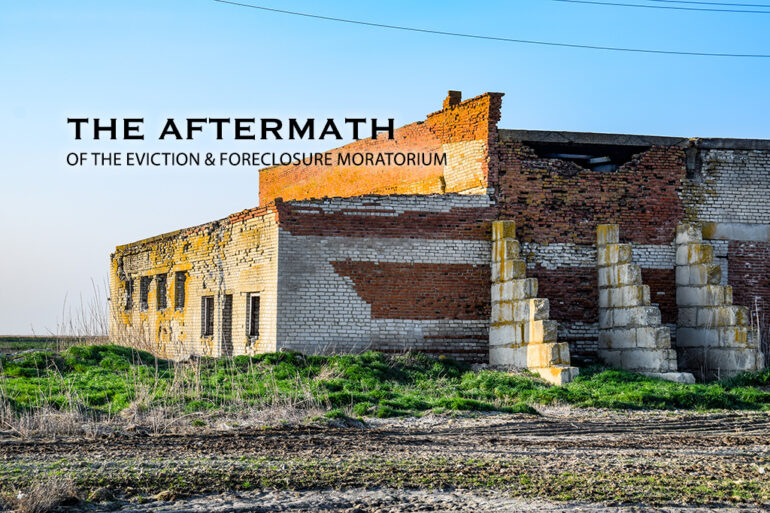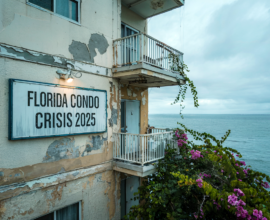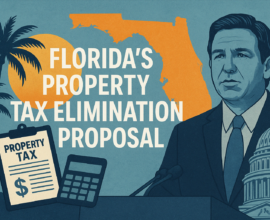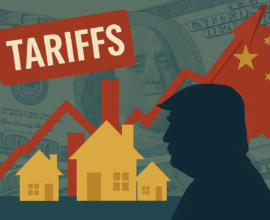The Aftermath of the Eviction & Foreclosure Moratorium
Property rights are at the heart of the Constitution of the United States of America. In a capitalist society, our day-to-day lives are centered around commerce, and for real estate investors this is especially true.
Owning property is a responsibility. Receiving compensation for utilizing that property to provide homes is the reward. The give and take dynamic is an exchange of energy that should never become unbalanced. Should one side be drained and the other side overflowed, it would lead to an eventual disaster. The entire system could collapse.
The Constitution is very clear that private property should never be taken without “just compensation.” Now, the ban on evictions has run its course and the damage has been done. What should have been done to protect both tenants and landlords from the ramifications of COVID-19 and the subsequent lockdown are no longer the primary concern.
The scales were already tipped, first in the tenant’s favor and now in the landlord’s favor, abruptly making enemies of them both.
The Aftermath of the Eviction Ban
On Thursday, August 26, 2021, the ban on evictions was lifted. Landlords who have been saddled with non-paying tenants prepare to file their evictions as the courts brace for a wave of back-to-back eviction cases. Over 22 million rental units belong to individual investors, and sadly they were the hardest hit by the eviction ban.
While the CARES Act tax provisions have removed the caps on writing off net operating losses, those with the greater balance sheets will see the greater tax breaks. Many landlords only had a few properties or maybe just one. Without the rent, they couldn’t pay the mortgage. Without a surplus of other paying tenants in their additional properties, they often had no compensation for the mortgage, and they paid it out of their own pockets.
Many had to decide between paying their own home’s mortgage or paying the mortgage on their tenant’s home. Stories emerged of landlords who are now homeless or bankrupt. One tenant told The Brunswick News that she had three units rented out to non-paying tenants and suspected that one may be subletting the unit while continuing to refuse to pay rent.
The Washington Post features heartbreaking stories of small landlords who are losing their properties. One is Julianna Hernandez, who has been unable to get her tenant to leave as she falls into possible foreclosure. All the while her tenant has threatened her with so much violence that she has had to contact the police.
Through the CARES Act, forbearance was an option for government-backed mortgages and could be applied for through the lender. This, however, was no guarantee. The policies of each lender varied in their application of the new mortgage forbearance act.
Most mortgage lenders like Huntington and PNC offered a mortgage deferral program that delayed payments for up to 90 days with the ability to apply for a 180-day extension if needed. Late payments were typically canceled but interest would still accrue.
According to Bankrate.com, some servicers did not follow the guidelines for the CARES Act, and one even charged a fee to those applying! Bankrate.com states that servicers were known to drag out the processing of the forbearance requests, put borrowers in forbearance without their consent, send out past due notes, and mistakenly tell borrowers that at the end of the deferral period they would have to pay back the full past due amount in one lump sum.
Even in the best of cases, most small landlords with non-paying tenants needed more than 90-180 days of forbearance.
In addition to the landlord having to pay the mortgage with no incoming rent, landlords were also as obligated as ever to keep up the maintenance on the property. As COVID-19 ravaged America, pipes did not stop leaking and appliances did not stop breaking. Properties may have deteriorated more than usual with people on lockdown.
The day-to-day wear and tear and the use of the furnace, plumbing, and appliances was constant. It is best practice to set aside a percentage of the rent collected each month for property maintenance, but there was no rent being collected. Over time, the small landlord kept up the property using their own savings.
Many Small Landlords Will Be Forced to Sell to Corporations
Now, landlords can remove these non-paying tenants from their properties. The question is, what will they do then?
For many small investors, the accumulated loss and debt is too high to keep the property. That’s why we are about to see mass amounts of rental properties sold to large corporations that were able to survive the ban on evictions. Many new and small investors will be leaving the game altogether.
According to Urban Wire, “Individual investors (sometimes called mom-and-pop landlords) make up 77% of small-building units.” It is important to remember that these investors are often in the same socioeconomic class as their tenants, and they are now bearing the full brunt of this crisis.
The middle class is being driven out of the real estate market, and an increasing number of properties is falling into the hands of large corporations. This will lead to rent increases as corporations will want top dollar for their rental units to the exclusion of all other factors.
With fewer local landlords operating rentals, the revenue will begin to slip away from communities and into the hands of corporations that may not be local or even in the same country as the property.
According to The Wall Street Journal, foreign investment firms have shifted their focus away from commercial properties and are buying up single-family suburban homes. If this continues, it will become less common for the owners of these properties to be invested in not just the property itself but also the neighborhood.
Homes Will Go into Foreclosure
According to ConsumerFinance.gov: “The COVID hardship forbearance applies to all federally backed or federally sponsored mortgages,” and so many homeowners chose to apply. However, even those who were able to obtain forbearance will now have to pay it back as the moratorium on foreclosures also ends.
According to Black Knight, it is estimated that 400,000 of the 1.71 million remaining forbearance plans are in their final month of forbearance as of September 2021. The foreclosure market will see a significant increase as properties are auctioned off at foreclosure auctions and sheriff’s sales.
While there will likely be an increase in the number of homes for sale at county auctions, there is also likely to be an increase in buyers waiting for those homes. Some savvy retail buyers widened their searches to include county foreclosure auctions during 2020 and 2021 as the MLS had limited inventory and high prices. It is safe to say that the foreclosure auctions will be quite active in the near future with many foreclosure evictions.
In addition to the increasing properties for sale at county auctions, the MLS may see a gradual increase in inventory. Homeowners who are struggling due to job loss are choosing to sell their properties to avoid foreclosure, an easy way out at a premium price with the hot seller’s market.
However, as inventory increases, those who absolutely need to sell to cash in equity or simply avoid foreclosure might not get these same blistering-hot market prices with the increase in sellers.
Many who want to sell could find that they are at a severe disadvantage when the formerly high prices of homes begin to drop. Those who purchased their home at a time when prices were on the higher end may now owe more on their mortgage than they can sell their home for.
The lost equity removes one of the few choices a homeowner affected by the COVID-19 crisis has left. Rather than short sell their house or wait for foreclosure, they may choose to abandon the home if it gets bad enough.
Zombie Foreclosures
Many homeowners were unable to withstand the pandemic. Some lost their jobs, could not pay the mortgage, and had to endure lockdown watching their homes fall into disrepair. Many have or will abandon their properties at the first sign of a default notice and go on to stay with family or friends while dodging notices and phone calls.
According to National Mortgage Professional, zombie foreclosures have been on a decline during the pandemic. This is due to inflated housing prices and increased equity. However, resources such as Rismedia.com have said that this will all change once foreclosures begin.
The compounded stress of debt, disrepair, disorder, and general loss will create the desperate conditions that result in zombie foreclosures. Once the properties are abandoned, they continue to fall into even worse condition. By the time the foreclosure commences, the bank often decides that the property is not even worth their time.
This creates an opportunity for an investor to buy the property at the foreclosure auction for significantly less than market value. It’s an especially lucrative opportunity for house flippers. If you can locate the owners of these distressed properties, they may be willing to sell to you before it can go into foreclosure.
In many cases, you will get a phenomenal deal as the owner will be glad to be free from the financial burden associated with the home. There are many articles on PropertyOnion.com on locating distressed properties in your area and strategies for making the most of them.
The Choice to Evict
The landlords who managed to keep their properties in good standing, even with non-paying tenants, now have a hard choice ahead of them. Despite countless articles in the media, not all landlords are chomping at the bit to evict their tenants. There are many things to consider.
The first is the legality of eviction in your area. While the federal ban on eviction has been lifted, there are still state and local laws in many areas that prohibit an eviction or require additional steps. Many landlords are discovering that the court system is currently and will continue to be pro-tenant.
Research the laws in your state, county, and municipality and, when in doubt, consult a real estate attorney. An article by Yahoo News advises that while most landlords could handle evictions themselves in the past, “the current climate is fraught with traps and obstacles.”
You may choose to do a simple eviction. Or if the tenant has regained their job and has assets, you may consider suing for all of the unpaid rent.
Some tenants wrongly believed that the eviction ban meant that their rent was excused during this time, and so they refused to pay. It was their assumption that after the ban, they would resume paying as normal. These tenants are now shocked to learn that they must pay the full amount of past due rent or be evicted.
For a tenant who rents at $1,500 per month and stopped paying rent in September of 2020, they would now find themselves owing $18,000 in September of 2021, perhaps along with some surprising penalty fees. The eviction ban did not prohibit late fees, which many tenants have accrued. While some landlords may choose to work with delinquent tenants by working out a payment plan, other landlords are angry and want the non-paying tenant out.
Other tenants genuinely were unable to pay their rent. Through job loss due to the pandemic or through serious illness, they were in a state of financial distress and had no way of paying for their housing. Hopefully they went through the proper channels, communicated with their landlord, and filed for rental assistance.
Tenants could apply for state and local programs, and their landlord would be paid the missing rent payments. This was an ideal solution for those who were able to apply and complete the process of enrolling.
For many, both landlord and tenant were met with constant delays and red tape despite all their attempts. If your tenant was proactive during their lapse in rent payments and has made an effort to work with you, consider working out a payment plan for them instead of hitting them at once with the lump sum of back rent.
Many landlords may proceed with filing for the eviction, perhaps seeing the opportunity to sell the property or raise the rent. The evictions that happen as a result of the pandemic, regardless of when they occurred, are going to result in a troubling phenomenon.
Most landlords and property managers will not rent to someone with an eviction on their record. According to the U.S. Census Bureau, 11.4 million renters are behind on rent and potentially facing eviction. Soon, we could see millions of Americans who are not only unhoused, but unhousable.
For the investor, the good news is there will be an abundance of tenants. The bad news is there will be many tenants who are employed with full-time jobs and in every other way are ideal tenants, but they have the scarlet letter of an eviction on their background. It is up to the individual investor to decide how they want to vet the new wave of high-risk tenants that will soon be clamoring for a place to live.
Always get a reference from the previous landlord and ask the important questions. Why were they evicted? If it was due to the pandemic, were they proactive? Did they communicate with the landlord every step of the way? Did they file for rental assistance?
Some landlords will reject any application with an eviction. Others will factor in context and perhaps charge a higher security deposit. Either way, the rental applications at the end of 2021 are going to look entirely different from the rental applications at the beginning of the year.
It is possible that new high-risk tenants will flock to the remaining smaller landlords, who will be more likely to analyze the circumstances of their pandemic eviction.
COVID-19 Has Permanently Impacted the Real Estate Industry
An unintended consequence of the eviction ban is that landlords may become disenchanted with owning rentals. Also, the upcoming generation may think twice before purchasing real estate investments. We have now all witnessed investors being told that their property is not theirs to do with what they wish.
We have seen small investors told that they must provide housing, free of charge to their tenants, and keep up their side of the transaction with nothing in return. What was intended to be a vessel of wealth and passive income for many has become a drain on personal finances and a liability.
The CARES Act allotted 2.2 trillion dollars for rental assistance. This was not put into a fund for landlords with non-paying tenants to apply for. Instead, the onus was put on the tenant to weave through the confusing web of paperwork, red tape, and unreasonable delays.
Many small landlords encouraged their tenants to apply and even helped them fill out the paperwork, and many are still waiting to receive the assistance. Many tenants did not apply for rental assistance at all and instead simply refused to pay rent.
Most states required tenants to submit a form for financial hardship, but landlords were instructed to take tenants at their word. No evidence on the part of the tenant was required. There were no objections allowed from the landlord.
A group of landlords in New York is suing, stating that they were denied due process. As Albany considers re-enacting the extension on the eviction bans, this lawsuit states that there must be a way for landlords to dispute the claims in court.
In an interview with NewYorkNOW, Christie Quinn stated: “All that would have to happen is that the legislature would have to introduce a piece of legislation, which would say there has to be a hearing to confirm that the situation, or the condition that the tenant says they’re in, they’re really in,” Quinn said.
The Constitution protects property rights because property rights are the lifeblood of the economy. Being told that our rights could be “temporarily interrupted” has created an imbalance in the real estate world, and it could be many years before its equilibrium is ever righted.









Lisa, you are a hero!!!
I appreciate the kind words. I’m glad you enjoyed the article.